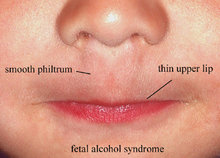Alcohol fetopathy
Fetal alcohol spectrum disorder (FASD) describes a spectrum of permanent and often devastating birth-defect syndromes caused by maternal consumption of alcohol during pregnancy. The main effect of fetal alcohol exposure is brain damage, which can be caused during any trimester, because the fetus's brain continues to develop throughout the entire pregnancy. The brain damage is often accompanied by, and reflected in, distinctive facial stigmata, as seen in the photograph on the right. more...
There are a number of subtypes, including full-blown fetal alcohol syndrome (FAS), and the less noticeable, but sometimes equally serious, possible fetal alcohol effects (PFAE). The latter is also known as prenatal exposure to alcohol (PEA) or alcohol-related neurodevelopmental disorder (ARND).
Features of FASD may include facial deformities, stunted physical and emotional development, memory and attention deficits, a tendency to impulsive behavior, inability to reason from cause to effect, a failure to comprehend the concept of time, difficulty telling fantasy from reality, inability to control sexual impulses, and an apparent lack of remorse. Secondary disabilities such as mental illness and drug addiction are also likely to develop. Unlike the primary disabilities, these do not reflect the central nervous system damage, but instead develop because the child has difficulty adapting to his environment.
Fetal alcohol exposure is regarded by researchers as the leading known cause of mental retardation in the Western world (Abel and Sokel 1987), surpassing both spina bifida and Down syndrome. In the United States alone, it is estimated that, every year, one in 750 babies born suffers from FAS, and 40,000 from PFAE.
Naming of the syndrome
Fetal alcohol syndrome was named in 1973 by two dysmorphologists, Kenneth Lyons Jones and David W. Smith of the University of Washington Medical School in Seattle. They identified a pattern of "craniofacial, limb, and cardiovascular defects associated with prenatal onset growth deficiency and developmental delay" in eight unrelated children, of three ethnic groups, born to mothers who were alcoholics (Jones et al 1973, p. 1267). The pattern of malformations indicated that the damage was prenatal. News of the discovery was "shocking, and met at first with disbelief" (Streissguth in Streissguth and Kanter 2002, p xi).
Dr. Paul Lemoine of Nantes, France had already published a study in a French medical journal in 1968 about children with distinctive features whose mothers were alcoholics (Lemoine et al in Streissguth and Kanter 2002, pp. 15 and 25). The Washington and Nantes findings were confirmed by a research group in Gothenburg, Sweden in 1979 (Olegard et al 1979).
Researchers in France, Sweden, and the United States were struck by how similar these children looked, though they were not related, and how they behaved in the same unfocused and hyperactive manner (ibid).
Within four years of the Washington discovery, animal studies, including non-human primate studies carried out at the University of Washington Primate Center by Dr Sterling Clarren, had confirmed that alcohol was a teratogen. By 1978, 245 cases of FAS had been reported by medical researchers, and the syndrome began to be described as the most frequent known cause of mental retardation.
Read more at Wikipedia.org

![A baby with FAS; his lifetime medical and welfare costs are calculated at $5 million. [1] A baby with FAS; his lifetime medical and welfare costs are calculated at $5 million. [1]](pics/Alcohol_Fetopathy_1.jpg)
![A newborn baby with FAS. The photograph is from the clinic of Dr. Jon Aase, University of New Mexico. [2] A newborn baby with FAS. The photograph is from the clinic of Dr. Jon Aase, University of New Mexico. [2]](pics/Alcohol_Fetopathy_2.jpg)

